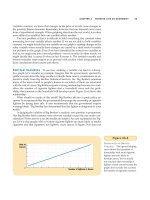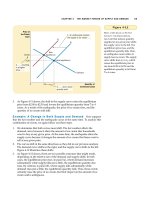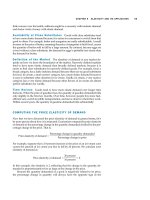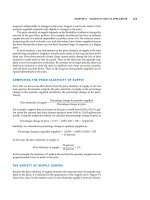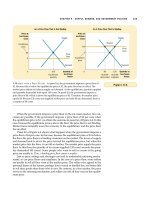Tài liệu Ten Principles of Economics - Part 26 ppt
Bạn đang xem bản rút gọn của tài liệu. Xem và tải ngay bản đầy đủ của tài liệu tại đây (210.63 KB, 10 trang )
CHAPTER 12 THE DESIGN OF THE TAX SYSTEM 259
We can fix the problem for John and Joan by raising the income exclusion
from $10,000 to $20,000 for married couples. But this change would create an-
other problem. In this case, Sam and Sally would pay a tax after getting married
of only $20,000, which is $2,500 less than they paid when they were single. Elim-
inating the marriage tax for John and Joan would create a marriage subsidy for
Sam and Sally.
In practice, the U.S. tax code is an uneasy compromise that includes a com-
bination of marriage taxes and marriage subsidies. According to a study by the
Congressional Budget Office, 42 percent of married couples pay a marriage tax,
averaging 2.0 percent of their income, while 51 percent of married couples pay
lower taxes by virtue of being wed, averaging 2.3 percent of their income.
Whether a couple is better off (from a tax standpoint) being married or shacked
up depends on how earnings are split between the two partners. If a man and
woman have similar incomes (like John and Joan), their wedding will most
likely raise their tax bill. But a marriage subsidy is likely if one partner earns
much more than the other, and especially if only one of them has earnings (like
Sam and Sally).
This problem has no simple solution. To see why, try designing an income
tax with the following four properties:
◆ Two married couples with the same total income should pay the same tax.
◆ When two people get married, their total tax bill should not change.
◆ A person or family with no income should pay no taxes.
◆ High-income taxpayers should pay a higher fraction of their incomes than
low-income taxpayers.
All four of these properties are appealing, yet it is impossible to satisfy all of
them simultaneously. Any income tax that satisfies the first three must violate
the fourth. The only income tax that satisfies the first three properties is a pro-
portional tax.
Some economists have advocated abolishing the marriage penalty by mak-
ing individuals rather than the family the taxpaying unit, a policy that many
European countries follow. This alternative might seem more equitable because
it would treat married and unmarried couples the same. Yet this change would
give up on the first of these properties: Families with the same total income
could end up paying different taxes. For example, if each married couple paid
taxes as if they were not married, then Sam and Sally would pay $22,500, and
John and Joan would pay $20,000, even though both couples have the same to-
tal income. Whether this alternative tax system is more or less fair than the cur-
rent marriage tax is hard to say.
TAX INCIDENCE AND TAX EQUITY
Tax incidence—the study of who bears the burden of taxes—is central to evaluat-
ing tax equity. As we first saw in Chapter 6, the person who bears the burden of a
tax is not always the person who gets the tax bill from the government. Because
taxes alter supply and demand, they alter equilibrium prices. As a result, they
affect people beyond those who, according to statute, actually pay the tax. When
260 PART FOUR THE ECONOMICS OF THE PUBLIC SECTOR
CASE STUDY WHO PAYS THE CORPORATE INCOME TAX?
The corporate income tax provides a good example of the importance of tax in-
cidence for tax policy. The corporate tax is popular among voters. After all, cor-
porations are not people. Voters are always eager to have their taxes reduced
and have some impersonal corporation pick up the tab.
But before deciding that the corporate income tax is a good way for the gov-
ernment to raise revenue, we should consider who bears the burden of the cor-
porate tax. This is a difficult question on which economists disagree, but one
thing is certain: People pay all taxes. When the government levies a tax on a cor-
poration, the corporation is more like a tax collector than a taxpayer. The bur-
den of the tax ultimately falls on people—the owners, customers, or workers of
the corporation.
Many economists believe that workers and customers bear much of the
burden of the corporate income tax. To see why, consider an example. Suppose
that the U.S. government decides to raise the tax on the income earned by car
companies. At first, this tax hurts the owners of the car companies, who receive
less profit. But, over time, these owners will respond to the tax. Because pro-
ducing cars is less profitable, they invest less in building new car factories. In-
stead, they invest their wealth in other ways—for example, by buying larger
houses or by building factories in other industries or other countries. With
fewer car factories, the supply of cars declines, as does the demand for auto-
workers. Thus, a tax on corporations making cars causes the price of cars to rise
and the wages of autoworkers to fall.
The corporate income tax shows how dangerous the flypaper theory of tax
incidence can be. The corporate income tax is popular in part because it appears
to be paid by rich corporations. Yet those who bear the ultimate burden of the
tax—the customers and workers of corporations—are often not rich. If the true
incidence of the corporate tax were more widely known, this tax might be less
popular among voters.
CASE STUDY THE FLAT TAX
A recurring topic of debate is whether the U.S. federal government should com-
pletely scrap the current tax system and replace it with a much simpler system
evaluating the vertical and horizontal equity of any tax, it is important to take ac-
count of these indirect effects.
Many discussions of tax equity ignore the indirect effects of taxes and are
based on what economists mockingly call the flypaper theory of tax incidence. Ac-
cording to this theory, the burden of a tax, like a fly on flypaper, sticks wherever it
first lands. This assumption, however, is rarely valid.
For example, a person not trained in economics might argue that a tax on ex-
pensive fur coats is vertically equitable because most buyers of furs are wealthy.
Yet if these buyers can easily substitute other luxuries for furs, then a tax on furs
might only reduce the sale of furs. In the end, the burden of the tax will fall more
on those who make and sell furs than on those who buy them. Because most work-
ers who make furs are not wealthy, the equity of a fur tax could be quite different
from what the flypaper theory indicates.
THIS WORKER PAYS PART OF THE
CORPORATE INCOME TAX
.
CHAPTER 12 THE DESIGN OF THE TAX SYSTEM 261
called the flat tax. The flat tax was proposed in the early 1980s by economist
Robert Hall and political scientist Alvin Rabushka. Since then, it has from time
to time caught the attention of politicians on both the political left (such as Jerry
Brown, former governor of California and sometime candidate in the Demo-
cratic presidential primaries) and the political right (such as Steve Forbes, multi-
millionaire publisher and sometime candidate in the Republican presidential
primaries).
Although flat-tax advocates have proposed various plans that differ in de-
tail, the essence of all the plans is a single, low tax rate that would apply to all
income in the economy. If the tax rate were set at 19 percent, for example, then
every taxpayer in the economy would face a marginal tax rate of 19 percent.
Most of the plans allow a certain amount of income to be excluded from the
tax. If the income exclusion were $10,000, for instance, then a person’s tax bill
would be
Tax ϭ 0.19 ϫ (Income Ϫ $10,000).
Because of the income exclusion, a flat tax can be progressive: Average tax rates
rise with income, even though the marginal tax rate is constant. Some of the
plans even allow a person with very low income (in this example, less than
$10,000) to pay a “negative tax” by receiving a check from the government.
Because the flat-tax proposal calls for a major overhaul of the tax system,
it raises almost every issue discussed in this chapter, especially the tradeoff
between efficiency and equity. Here are some of the points made by flat-tax
advocates:
◆ The flat tax would eliminate many of the deductions allowed under the
current income tax, such as deductions for mortgage interest payments
and charitable giving. By broadening the tax base in this way, the flat tax is
able to reduce the marginal tax rates that most people face. Lower tax
rates mean greater economic efficiency. Thus, flat-tax advocates claim that
this change would expand the size of the economic pie.
◆ Because the flat tax is so simple, the administrative burden of taxation
would be greatly reduced. Flat-tax advocates claim that many taxpayers
could file their returns on a postcard. Because all taxpayers would pay
the same low tax rate on all forms of income, people would have less
incentive to hire tax lawyers and accountants to take advantage of
loopholes.
◆ Because all taxpayers would face the same marginal tax rate, the tax
could be collected at the source of income rather than from the person
who receives the income. Income from corporate profit, for instance,
would be taxed at the corporate level rather than at the personal level.
This additional simplification also reduces administrative costs.
◆ The flat tax would replace both the personal income tax and the corporate
income tax. All income, whether from working at a job or from owning
shares in a corporation, would be taxed once at the same marginal rate.
The flat tax would eliminate the current double taxation of corporate
profits, which now discourages corporations from investing in new plants
and equipment.
262 PART FOUR THE ECONOMICS OF THE PUBLIC SECTOR
◆ In computing income for tax purposes, businesses would be allowed to
deduct all legitimate business expenses, including expenses on new
investment goods. This deduction for investment makes the flat tax more
like a consumption tax than an income tax. As a result, a change to a flat
tax would increase the incentive to save (or, more precisely, would
eliminate the current tax system’s disincentive to save).
In short, advocates of the flat tax claim that there is a strong efficiency argument
for this dramatic tax reform.
Critics of the flat tax are sympathetic with the goal of a simpler and more ef-
ficient tax system, but they oppose the flat tax because they believe that it gives
too little weight to the goal of vertical equity. They claim that a flat tax would be
less progressive than the current tax system and, in particular, would shift some
of the tax burden from the wealthy to the middle class. This concern may well
be justified, but no one knows for sure. Our study of tax incidence shows that
the burden of a tax is not necessarily borne by the person who sends the check
to the government. If the flat tax did encourage greater saving, as advocates
claim, it would lead to more rapid economic growth, which would benefit all
taxpayers. No one can be certain, however, about how large the impact on eco-
nomic growth would be.
QUICK QUIZ: Explain the benefits principle and the ability-to-pay principle.
◆ What are vertical equity and horizontal equity? ◆ Why is studying tax
incidence important for determining the equity of a tax system?
CONCLUSION: THE TRADEOFF BETWEEN
EQUITY AND EFFICIENCY
Almost everyone agrees that equity and efficiency are the two most important
goals of the tax system. But often these two goals conflict. Many proposed changes
in the tax laws increase efficiency while reducing equity, or increase equity while
reducing efficiency. People disagree about tax policy often because they attach dif-
ferent weights to these two goals.
The recent history of tax policy shows how political leaders differ in their
views on equity and efficiency. When Ronald Reagan was elected president in
1980, the marginal tax rate on the earnings of the richest Americans was 50 per-
cent. On interest income, the marginal tax rate was 70 percent. Reagan argued that
such high tax rates greatly distorted economic incentives to work and save. In
other words, he claimed that these high tax rates cost too much in terms of eco-
nomic efficiency. Tax reform was, therefore, a high priority of his administration.
Reagan signed into law large cuts in tax rates in 1981 and then again in 1986. When
Reagan left office in 1989, the richest Americans faced a marginal tax rate of only
28 percent. During the four years of the Bush presidency, the top tax rate increased
slightly to 31 percent.
When Bill Clinton ran for president in 1992, he argued that the rich were
not paying their fair share of taxes. In other words, the low tax rates on the rich
CHAPTER 12 THE DESIGN OF THE TAX SYSTEM 263
violated his view of vertical equity. One of President Clinton’s first acts was to pro-
pose raising the tax rates on the highest levels of income. In 1993 the tax rates on
the richest Americans became about 40 percent.
Economics alone cannot determine the best way to balance the goals of effi-
ciency and equity. This issue involves political philosophy as well as economics.
But economists do have an important role in the political debate over tax policy:
They can shed light on the tradeoffs that society faces and can help us avoid poli-
cies that sacrifice efficiency without any benefit in terms of equity.
◆ The U.S. government raises revenue using various taxes.
The most important taxes for the federal government
are individual income taxes and payroll taxes for social
insurance. The most important taxes for state and local
governments are sales taxes and property taxes.
◆ The efficiency of a tax system refers to the costs it
imposes on taxpayers. There are two costs of taxes
beyond the transfer of resources from the taxpayer to
the government. The first is the distortion in the
allocation of resources that arises as taxes alter
incentives and behavior. The second is the
administrative burden of complying with the tax laws.
◆ The equity of a tax system concerns whether the tax
burden is distributed fairly among the population.
According to the benefits principle, it is fair for people
to pay taxes based on the benefits they receive from the
government. According to the ability-to-pay principle, it
is fair for people to pay taxes based on their capability
to handle the financial burden. When evaluating the
equity of a tax system, it is important to remember a
lesson from the study of tax incidence: The distribution
of tax burdens is not the same as the distribution of
tax bills.
◆ When considering changes in the tax laws,
policymakers often face a tradeoff between efficiency
and equity. Much of the debate over tax policy arises
because people give different weights to these two
goals.
Summary
budget surplus, p. 248
budget deficit, p. 248
average tax rate, p. 252
marginal tax rate, p. 252
lump-sum tax, p. 254
benefits principle, p. 255
ability-to-pay principle, p. 255
vertical equity, p. 256
horizontal equity, p. 256
proportional tax, p. 256
regressive tax, p. 256
progressive tax, p. 256
Key Concepts
1. Over the past several decades, has government grown
more or less slowly than the rest of the economy?
2. What are the two most important sources of revenue for
the U.S. federal government?
3. Explain how corporate profits are taxed twice.
4. Why is the burden of a tax to taxpayers greater than the
revenue received by the government?
5. Why do some economists advocate taxing consumption
rather than income?
6. Give two arguments why wealthy taxpayers should pay
more taxes than poor taxpayers.
7. What is the concept of horizontal equity, and why is it
hard to apply?
8. Describe the arguments for and against replacing the
current tax system with a flat tax.
Questions for Review
264 PART FOUR THE ECONOMICS OF THE PUBLIC SECTOR
1. Government spending in the United States has grown as
a share of national income over time. What changes in
our economy and our society might explain this trend?
Do you expect the trend to continue?
2. In a published source or on the Internet, find out
whether the U.S. federal government had a budget
deficit or surplus last year. What do policymakers
expect to happen over the next few years? (Hint: The
Web site of the Congressional Budget Office is
www.cbo.gov.)
3. The information in many of the tables in this chapter
is taken from the Economic Report of the President,
which appears annually. Using a recent issue of
the report at your library, answer the following
questions and provide some numbers to support
your answers.
a. Figure 12-1 shows that government revenue as a
percentage of total income has increased over time.
Is this increase primarily attributable to changes in
federal government revenue or in state and local
government revenue?
b. Looking at the combined revenue of the federal
government and state and local governments, how
has the composition of total revenue changed over
time? Are personal income taxes more or less
important? Social insurance taxes? Corporate
profits taxes?
c. Looking at the combined expenditures of the
federal government and state and local
governments, how have the relative shares of
transfer payments and purchases of goods and
services changed over time?
4. The chapter states that the elderly population in the
United States is growing more rapidly than the total
population. In particular, the number of workers is
rising slowly, while the number of retirees is rising
quickly. Concerned about the future of Social Security,
some members of Congress propose a “freeze” on the
program.
a. If total expenditures were frozen, what would
happen to benefits per retiree? To tax payments per
worker? (Assume that Social Security taxes and
receipts are balanced in each year.)
b. If benefits per retiree were frozen, what would
happen to total expenditures? To tax payments per
worker?
c. If tax payments per worker were frozen, what
would happen to total expenditures? To benefits
per retiree?
d. What do your answers to parts (a), (b), and (c)
imply about the difficult decisions faced by
policymakers?
5. Suppose you are a typical person in the U.S. economy.
You pay a flat 4 percent of your income in a state income
tax and 15.3 percent of your labor earnings in federal
payroll taxes (employer and employee shares
combined). You also pay federal income taxes as in
Table 12-3. How much tax of each type do you pay if
you earn $20,000 a year? Taking all taxes into account,
what are your average and marginal tax rates? What
happens to your tax bill and to your average and
marginal tax rates if your income rises to $40,000?
6. Some states exclude necessities, such as food and
clothing, from their sales tax. Other states do not.
Discuss the merits of this exclusion. Consider both
efficiency and equity.
7. Explain how individuals’ behavior is affected by the
following features of the federal tax code.
a. Contributions to charity are tax deductible.
b. Sales of beer are taxed.
c. Interest that a homeowner pays on a mortgage is
tax deductible.
d. Realized capital gains are taxed, but accrued gains
are not. (When someone owns a share of stock that
rises in value, she has an “accrued” capital gain. If
she sells the share, she has a “realized” gain.)
8. Suppose that your state raises its sales tax from
5 percent to 6 percent. The state revenue commissioner
forecasts a 20 percent increase in sales tax revenue. Is
this plausible? Explain.
9. Consider two of the income security programs in the
United States: Temporary Assistance for Needy Families
(TANF) and the Earned Income Tax Credit (EITC).
a. When a woman with children and very low income
earns an extra dollar, she receives less in TANF
benefits. What do you think is the effect of this
feature of TANF on the labor supply of low-income
women? Explain.
b. The EITC provides greater benefits as low-income
workers earn more income (up to a point). What do
you think is the effect of this program on the labor
supply of low-income individuals? Explain.
Problems and Applications
CHAPTER 12 THE DESIGN OF THE TAX SYSTEM 265
c. What are the disadvantages of eliminating TANF
and allocating the savings to the EITC?
10. The Tax Reform Act of 1986 eliminated the deductibility
of interest payments on consumer debt (mostly credit
cards and auto loans) but maintained the deductibility
of interest payments on mortgages and home equity
loans. What do you think happened to the relative
amounts of borrowing through consumer debt and
home equity debt?
11. Categorize each of the following funding schemes as
examples of the benefits principle or the ability-to-pay
principle.
a. Visitors to many national parks pay an entrance fee.
b. Local property taxes support elementary and
secondary schools.
c. An airport trust fund collects a tax on each plane
ticket sold and uses the money to improve airports
and the air traffic control system.
12. Any income tax schedule embodies two types of tax
rates—average tax rates and marginal tax rates.
a. The average tax rate is defined as total taxes paid
divided by income. For the proportional tax system
presented in Table 12-7, what are the average tax
rates for people earning $50,000, $100,000, and
$200,000? What are the corresponding average tax
rates in the regressive and progressive tax systems?
b. The marginal tax rate is defined as the extra taxes
paid on additional income divided by the increase
in income. Calculate the marginal tax rate for the
proportional tax system as income rises from
$50,000 to $100,000. Calculate the marginal tax rate
as income rises from $100,000 to $200,000. Calculate
the corresponding marginal tax rates for the
regressive and progressive tax systems.
c. Describe the relationship between average tax rates
and marginal tax rates for each of these three
systems. In general, which rate is relevant for
someone deciding whether to accept a job that pays
slightly more than her current job? Which rate is
relevant for judging the vertical equity of a tax
system?
13. What is the efficiency justification for taxing
consumption rather than income? If the United States
were to adopt a consumption tax, do you think that
would make the U.S. tax system more or less
progressive? Explain.
14. If a salesman takes a client to lunch, part of the cost of
the lunch is a deductible business expense for his
company. Some members of Congress have argued that
this feature of the tax code benefits relatively wealthy
businesspeople and should be eliminated. Yet their
arguments have been met with greater opposition from
eating and drinking establishments than from
companies themselves. Explain.
IN THIS CHAPTER
YOU WILL . . .
Examine the
relationship
between short-run
and long-run costs
Learn the meaning
of average total
cost and marginal
cost and how they
are related
Examine what items
are included in a
firm’s costs of
production
Analyze the link
between a firm’s
production process
and its total costs
Consider the shape
of a typical firm’s
cost curves
The economy is made up of thousands of firms that produce the goods and ser-
vices you enjoy every day: General Motors produces automobiles, General Electric
produces lightbulbs, and General Mills produces breakfast cereals. Some firms,
such as these three, are large; they employ thousands of workers and have thou-
sands of stockholders who share in the firms’ profits. Other firms, such as the local
barbershop or candy store, are small; they employ only a few workers and are
owned by a single person or family.
In previous chapters we used the supply curve to summarize firms’ produc-
tion decisions. According to the law of supply, firms are willing to produce and sell
a greater quantity of a good when the price of the good is higher, and this response
leads to a supply curve that slopes upward. For analyzing many questions, the law
of supply is all you need to know about firm behavior.
In this chapter and the ones that follow, we examine firm behavior in more de-
tail. This topic will give you a better understanding of what decisions lie behind
THE COSTS OF PRODUCTION
269
270 PART FIVE FIRM BEHAVIOR AND THE ORGANIZATION OF INDUSTRY
the supply curve in a market. In addition, it will introduce you to a part of eco-
nomics called industrial organization—the study of how firms’ decisions regarding
prices and quantities depend on the market conditions they face. The town in
which you live, for instance, may have several pizzerias but only one cable televi-
sion company. How does this difference in the number of firms affect the prices in
these markets and the efficiency of the market outcomes? The field of industrial or-
ganization addresses exactly this question.
As a starting point for the study of industrial organization, this chapter exam-
ines the costs of production. All firms, from Delta Air Lines to your local deli, in-
cur costs as they make the goods and services that they sell. As we will see in the
coming chapters, a firm’s costs are a key determinant of its production and pricing
decisions. Establishing what a firm’s costs are, however, is not as straightforward
as it might seem.
WHAT ARE COSTS?
We begin our discussion of costs at Hungry Helen’s Cookie Factory. Helen, the
owner of the firm, buys flour, sugar, flavorings, and other cookie ingredients. She
also buys the mixers and ovens and hires workers to run this equipment. She then
sells the resulting cookies to consumers. By examining some of the issues that He-
len faces in her business, we can learn some lessons that apply to all firms in the
economy.
TOTAL REVENUE, TOTAL COST, AND PROFIT
We begin with the firm’s objective. To understand what decisions a firm makes, we
must understand what it is trying to do. It is conceivable that Helen started her
firm because of an altruistic desire to provide the world with cookies or, perhaps,
out of love for the cookie business. More likely, however, Helen started her busi-
ness to make money. Economists normally assume that the goal of a firm is to max-
imize profit, and they find that this assumption works well in most cases.
What is a firm’s profit? The amount that the firm receives for the sale of its out-
put (cookies) is called its total revenue. The amount that the firm pays to buy in-
puts (flour, sugar, workers, ovens, etc.) is called its total cost. Helen gets to keep
any revenue that is not needed to cover costs. We define profit as a firm’s total rev-
enue minus its total cost. That is,
Profit ϭ Total revenue Ϫ Total cost.
Helen’s objective is to make her firm’s profit as large as possible.
To see how a firm goes about maximizing profit, we must consider fully how
to measure its total revenue and its total cost. Total revenue is the easy part: It
equals the quantity of output the firm produces times the price at which it sells its
output. If Helen produces 10,000 cookies and sells them at $2 a cookie, her total
revenue is $20,000. By contrast, the measurement of a firm’s total cost is more
subtle.
total revenue
the amount a firm receives for the
sale of its output
total cost
the market value of the inputs a firm
uses in production
profit
total revenue minus total cost
